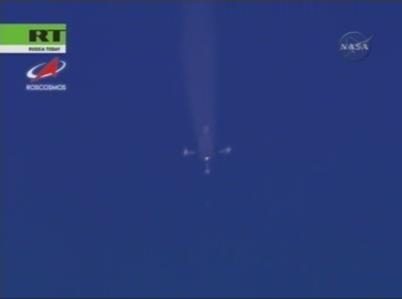R-7 family on:
[Wikipedia]
[Google]
[Amazon]
 The R-7 family of rockets (russian: Р-7) is a series of rockets, derived from the Soviet
The R-7 family of rockets (russian: Р-7) is a series of rockets, derived from the Soviet
 The Korolev Cross is a visual phenomenon observed in the smoke plumes of the R-7 series rockets during separation of the four liquid-fueled booster rockets attached to the core stage.NASA TV coverage of Soyuz TMA-12 launch As the boosters fall away from the rocket, they pitch over symmetrically due to aerodynamic forces acting upon them, forming a cross-like shape behind the rocket. The effect is named after Sergey Korolev; the designer of the R-7 rocket. When the rocket is launched into clear skies, the effect can be seen from the ground at the launch site.
The Korolev Cross is a visual phenomenon observed in the smoke plumes of the R-7 series rockets during separation of the four liquid-fueled booster rockets attached to the core stage.NASA TV coverage of Soyuz TMA-12 launch As the boosters fall away from the rocket, they pitch over symmetrically due to aerodynamic forces acting upon them, forming a cross-like shape behind the rocket. The effect is named after Sergey Korolev; the designer of the R-7 rocket. When the rocket is launched into clear skies, the effect can be seen from the ground at the launch site.
Rocket R-7
from S.P. Korolev Rocket and Space Corporation Energia, a Russian rocket and space contractor {{DEFAULTSORT:R-07 Space launch vehicles of the Soviet Union Soviet inventions Rocket families Space launch vehicles of Russia
R-7 Semyorka
The R-7 Semyorka (russian: link=no, Р-7 Семёрка), officially the GRAU index 8K71, was a Soviet missile developed during the Cold War, and the world's first intercontinental ballistic missile. The R-7 made 28 launches between 1957 and 1 ...
, the world's first ICBM
An intercontinental ballistic missile (ICBM) is a ballistic missile with a range greater than , primarily designed for nuclear weapons delivery (delivering one or more thermonuclear warheads). Conventional, chemical, and biological weapons c ...
. More R-7 rockets have been launched than any other family of large rockets.
When Soviet nuclear warheads became lighter, the R-7 turned out to be impractical as a ballistic missile, and there were no other heavy payloads with a military application. However, long-term development has made the rockets useful in the Soviet, and later, Russian space programmes. Their purpose shifted primarily to launching satellites, probes, manned and unmanned spacecraft, and other non-threatening payloads. The R-7 family consists of both missiles and orbital carrier rockets. Derivatives include the Vostok, Voskhod and Soyuz rockets, which as of 2022 have been used for all Soviet, and later Russian human spaceflight
Human spaceflight (also referred to as manned spaceflight or crewed spaceflight) is spaceflight with a crew or passengers aboard a spacecraft, often with the spacecraft being operated directly by the onboard human crew. Spacecraft can also be ...
s. The type has a unique configuration where four break-away liquid-fueled engines surround a central core. The core acts as, in effect, a "second stage" after the other four engines are jettisoned. These rockets are expendable.
Later modifications were standardised around the Soyuz design. The Soyuz-2 is currently in use.
The Soyuz-FG was retired in 2019 in favour of the Soyuz-2.1a. R-7 rockets are launched from the Baikonur Cosmodrome
The Baikonur Cosmodrome ( kk, Байқоңыр ғарыш айлағы, translit=Baiqoñyr ğaryş ailağy, ; russian: Космодром Байконур, translit=Kosmodrom Baykonur, ) is a spaceport in an area of southern Kazakhstan leased to R ...
, Plesetsk Cosmodrome, Guiana Space Centre (since 2011, see Soyuz at the Guiana Space Centre), and the Vostochny Cosmodrome (first launch 2016).
Summary of variants
All the R-7 family rockets are listed here by date of introduction. Most of the early R-7 variants have been retired. Active versions (as of 2022) are shown in green.Korolev Cross
See also
*1957 in spaceflight
The first orbital flight of an artificial satellite, Sputnik 1, was launched in October 1957, by the Soviet Union. In November, the second orbital flight took place. The Soviet Union launched the first animal to orbit the Earth, a dog, Laika ...
* List of R-7 launches
* Comparison of orbital launchers families
References
* *External links
Rocket R-7
from S.P. Korolev Rocket and Space Corporation Energia, a Russian rocket and space contractor {{DEFAULTSORT:R-07 Space launch vehicles of the Soviet Union Soviet inventions Rocket families Space launch vehicles of Russia